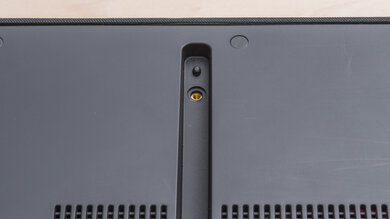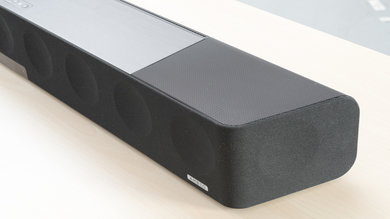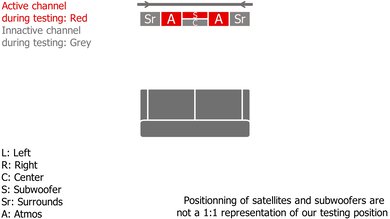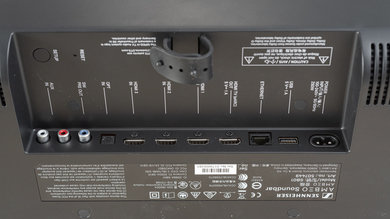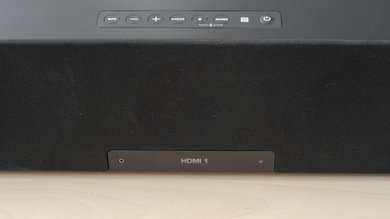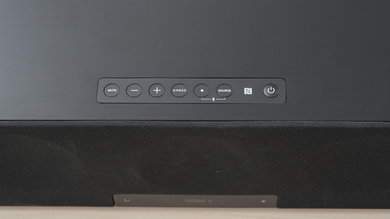The Sennheiser AMBEO Soundbar MAX is a 5.1.4 setup with 13 speakers that delivers an impressive immersive experience for a standalone bar. This system has a unique 3D mode that helps sounds come from over and around you, without the need for wireless speakers. The bar gets very loud, but unfortunately, it's a bit on the bass-light side, especially with stereo content. On the other hand, it has a lot of inputs and supports pretty much every audio format.
Our Verdict
The Sennheiser AMBEO Soundbar MAX is great for mixed usage. It has a unique 3D mode that greatly improves the surround performance, which is great for movies. Its overall sound profile is pretty accurate, but it's lacking a bit in the bass range. While the bar still produces a good amount of bass, it's audibly lower than other frequencies at the same volume, which gives it a disappointing feel on stereo bass-heavy content like some music genres. On the upside, it has a room correction feature that adapts to your room and the reproduction of voices in accurate and clear.
-
Impressive immersive sound for a stand-alone bar.
-
Good performance with surround content.
-
Supports all audio formats.
-
Well-built design.
-
Very heavy.
-
Disappointing bass performance, especially on stereo content.
The Sennheiser AMBEO Soundbar MAX is excellent for dialogue-focused TV shows. It has a good overall sound profile with accurate mid-range performance, resulting in an accurate reproduction of voices with content like audiobooks, podcasts, or voices in TV shows. It lacks a bit of bass, but this shouldn’t be too bad for this use. On the upside, the bar can get very loud and has a few features like a dialogue enhancement and a night mode for a better listening experience. You’re also able to stream content wirelessly via Bluetooth, Wi-Fi, and use its built-in Chromecast.
The Sennheiser AMBEO Soundbar MAX is good for music. Without AMBEO mode, the volume of the bass is much lower than with it on. However, it performs quite well for music genres that don’t have that much bass. Also, it has a room correction feature to tweak out its sound quality depending on your room. The soundstage is decent and the bar performs well at max volume, which is pretty loud.
The Sennheiser AMBEO Soundbar MAX is good for movies. When using the AMBEO 3D mode, it's quite impressive and offers an immersive listening experience with movies thanks to the high number of speakers and the support for Atmos content. It performs well with surround sound movies overall and you’ll have the impression that the objects are localized around and over you, which is impressive for a stand-alone bar.
- 8.0 Mixed Usage
- 8.5 Dialogue/TV Shows
- 7.6 Music
- 7.8 Movies
- Updated Jun 19, 2023: Converted to Test Bench 1.2. Updated the results for audio format support via ARC/eARC, HDMI In, and Optical. Added Video Passthrough to TV results as well.
- Updated Mar 01, 2023: Added cable lengths to In The Box.
- Updated Mar 01, 2023: Converted to Test Bench 1.1. With this update, we've added a Mounting test and added information aboutSubwoofer Output, Spotify Connect, and Microphone Mute.
- Updated Nov 30, 2022: Added market comparison with the Sennheiser AMBEO Soundbar Plus to Dimensions - Bar.
- Updated Nov 28, 2022: Updated 3.5mm AUX from YES to NO in Physical Inputs - Bar.
- Updated Sep 08, 2022: Renamed the bar to the Sennheiser AMBEO Soundbar MAX to reflect updated marketing from the manufacturer.
- Updated Apr 28, 2022: We've updated the bar to firmware version 1.0.237. The Wireless Playback results are updated to include support for Apple AirPlay 2, Spotify Connect, and Tidal Connect. The results in the App box also reflect the new app design. The firmware update didn't change the bar's sound.
- Updated May 20, 2021: Converted to Test Bench 1.0.
- Updated Sep 27, 2019: Review published.
Compared To Other Soundbars
The Sennheiser AMBEO Soundbar MAX is a very unique product. This stand-alone bar has 13 speakers and tries to do it all in a single 5.1.4 unit. It does a decent job with most content and gives an impressive and immersive listening experience when using the AMBEO mode. However, this is the biggest and heaviest bar we've reviewed so far, so it might be hard for some people to fit it in their home theater setup. See our recommendations for the best soundbars, the best Dolby Atmos soundbars, and the best soundbars 5.1.
The Sennheiser AMBEO Soundbar MAX and the Sonos Arc are both very premium standalone bars. The Sennheiser reproduces a more extended low-bass thanks to its integrated subwoofer. It supports more wireless playback options, and unlike the Sonos, it offers a graphic EQ, presets, and a Full HDMI In port. However, the Sonos is better built with a better soundstage performance. Unlike the Sennheiser, it has bass and treble adjustments and built-in voice assistant support. You can also upgrade it to the Sonos Arc with Sub + One SL Speakers for better performance.
The Sennheiser AMBEO Soundbar MAX and the Samsung HW-Q990B are two very different soundbars. They're both premium setups with Dolby Atmos support, but the Sennheiser is a standalone bar, as opposed to the Samsung, which has a subwoofer and satellites. The Samsung's a more versatile pick, with more bass out-of-the-box and a better soundstage. It's better for surround sound and Dolby Atmos content, with more enhancement features on hand. If you don't have room for a sub and satellites, the AMBEO is a good alternative. Its large, heavy design isn't for everyone, though.
The Sennheiser AMBEO Soundbar MAX is better than the standalone Sony HT-A7000. The Sennheiser is a 5.1.4 setup with better center, surround, and Atmos performances. It gets louder than the Sony, and it reproduces a more extended low-bass. It also has a graphic EQ, which some users may prefer for sound customization. However, the Sony is better-built, and it has a better stereo soundstage.
The Sennheiser AMBEO Soundbar MAX is better than the Sennheiser AMBEO Soundbar Plus. The MAX is a bigger setup with a lot more rumble in the bass, which is great for action-packed movies and bass-heavy music genres. Both bars support many audio formats and offer similar sound enhancement features, but the MAX's large design brings a more cinematic sound, especially with Atmos content. However, it doesn't have built-in voice assistant support like the Plus.
The Bose Smart Soundbar 900 with Speakers + Bass Module is better than the Sennheiser AMBEO Soundbar MAX. The Bose comes with a dedicated subwoofer and satellites, and it can reproduce more bass out-of-the-box. It's better built, and it has better soundstage and surround performances. That said, some users may prefer the Sennheiser model's unique standalone design. It also gets louder than the Bose.
The Sennheiser AMBEO Soundbar MAX and the Bose Smart Soundbar 900 are both versatile standalone soundbars. Thanks to its sub, which is integrated into the bar, the Sennheiser reproduces a more extended low-bass. It also has more sound enhancement features like a graphic EQ and presets, though this may not be worth the value for some users. The Bose is also better built, with built-in voice assistant support. It also has a better soundstage.
The Sonos Arc with Sub + One SL Speakers is slightly better than the Sennheiser AMBEO Soundbar MAX. The Sonos is better built, with better surround and soundstage performances. Unlike the Sennheiser, it has room correction and built-in voice assistant support. However, the Sennheiser gets louder. It comes with a graphic EQ and presets as well as a Full HDMI In port. Some users may also prefer its standalone design.
Depending on your listening habits, you may prefer either the Sennheiser AMBEO Soundbar MAX or the Sonos Beam (Gen 2). They're both standalone bars but with very different designs. The Sennheiser is a large, heavy bar with integrated subwoofers that help it reproduce a more extended low-bass. It can also get much louder than the smaller Sonos, and its Atmos performance is better. Some people may prefer the Sonos bar's small, compact design. It has a better soundstage, and some users may find it offers a better value than the Sennheiser.
The Sennheiser AMBEO Soundbar MAX and the Devialet Dione are both very premium standalone bars with solid performances, but the Sennheiser is better overall. The Sennheiser doesn't offer as much boom in the bass as the Devialet out-of-the-box, but since it has more sound customization tools, you can easily adjust it to get a similar sound. It has a better surrounds performance, as well as support for more audio formats like DTS. There are also three HDMI In ports for passthrough, which the Devialet lacks. It's a bit larger than the Devialet, though, which isn't ideal for everyone.
The JBL Bar 9.1 is a better 5.1.4 soundbar than the Sennheiser AMBEO Soundbar MAX. The JBL is better built, it's smaller, and its satellite speakers are completely wireless, which means they can be placed virtually anywhere you have room. It also sounds significantly more balanced and neutral, while its surround and height performances are better. However, the Sennheiser has three Full HDMI In ports, a parametric EQ, and it can get louder. It also has a companion app that you can use to control all the features of the soundbar. If you don't mind its bulky size, the Sennheiser is a good choice if you don't have the room for a full setup.
The Sennheiser AMBEO Soundbar MAX is more versatile than the Bang & Olufsen Beosound Stage. The Sennheiser is a 5.1.4 standalone bar that can reproduce a more extended low-bass. It has much better surround and Atmos performances and supports DTS content. That said, the 3.0 Bang & Olufsen may provide a better value, especially for listeners who mostly want to use their soundbar with music and dialogue-centric content like TV shows. It also has a smaller, lighter design compared to the Sennheiser.
The Sennheiser AMBEO Soundbar MAX is better than the standalone Bose Smart Soundbar 700. The Sennheiser supports Dolby Atmos content and has a better surrounds performance. It also reproduces a more extended low bass and comes with a graphic EQ and a Full HDMI In port. The Bose is better built, with a better soundstage and built-in voice assistant support.
The Sony HT-A9 with Bass Module and the Sennheiser AMBEO Soundbar MAX are two very different setups. The Sennheiser is a large standalone soundbar. It gets louder than the Sony with less compression at max volume and has a better center channel performance. The Sony has a unique design with four speakers, a small control box, and its subwoofer. It's better-built, with better soundstage, surround, and Atmos performances.
The Sonos Beam and the Sennheiser AMBEO Soundbar MAX are two very different standalone setups. The Sennheiser is one of the largest and heaviest bars we've tested. It can reproduce a more extended low-bass, can become louder, has a better surround performance, and supports Atmos content. However, the Sonos is a very compact 3.0 setup. It has a better soundstage and is very suitable for dialogue-centric content like TV shows.
The Sennheiser AMBEO Soundbar MAX is better than the Sony HT-A7000 with Speakers + Bass Module. The Sennheiser is a 5.1.4 soundbar with a standalone design. It has a better Atmos performance and gets louder with less compression at max volume. Its large, heavy design may not be ideal for all users. The 7.1.2 Sony has a dedicated sub and satellites and can reproduce a little more bass out-of-the-box. Its surround and soundstage performances are better, too.
Depending on your listening habits, you may prefer either the Klipsch Cinema 800 or the Sennheiser AMBEO Soundbar MAX. They're both very versatile setups, but the Sennheiser is a bit better for movies. It has better surround and Atmos performances, and unlike the Klipsch, it supports DTS content. That said, its large, heavy standalone design may not be ideal for everyone. The 3.1 Klipsch comes with a dedicated sub, and it reproduces more bass out-of-the-box. It also has a better soundstage.
The Sennheiser AMBEO Soundbar MAX and the Klipsch Cinema 1200 are both 5.1.4 setups, but they cater to different types of listeners. The Sennheiser is a standalone bar with a uniquely large and heavy design. It's better-built, and unlike the Klipsch, it supports DTS content. However, the Klipsch comes with both a dedicated subwoofer and satellites. It has better soundstage and surround performances, and there's a lot more emphasis in the bass range out-of-the-box compared to the Sennheiser.
The Sennheiser AMBEO Soundbar MAX is slightly better for mixed usage than the Bose Smart Soundbar 700 with Speakers + Bass Module. The Sennheiser supports Dolby Atmos content, and it gets louder. It comes with a graphic EQ and presets as well as a Full HDMI In port. Some users may prefer its standalone design compared to the Bose, which comes with a dedicated sub and satellites. That said, the Bose's sub helps reproduce a more extended low-bass, and its satellites help improve its surround performance. The Bose is also better built and has a better stereo soundstage.
The Sennheiser AMBEO Soundbar MAX is better than the Bowers & Wilkins Panorama 3. While they're both premium standalone setups, the Sennheiser has better soundstage, surround, and Atmos performances. It comes with more sound enhancement features, too. Also, the Sennheiser's integrated sub can reproduce more low-bass than the B&W's. Keep in mind that the Sennheiser is quite large and heavy, though, so it's not ideal for smaller spaces.
The Samsung HW-Q800A and the Sennheiser AMBEO Soundbar MAX are both versatile setups. The Samsung model has a better soundstage, and it can reproduce more bass out-of-the-box. It even has built-in voice assistant support. While the Sennheiser's large, bulky design may not be ideal for all users, it does offer better surround and Atmos performances. It also gets louder than the Samsung soundbar, and some users may prefer that it's a standalone bar.
The Samsung HW-Q900A is a bit better for mixed usage than the Sennheiser AMBEO Soundbar MAX. The Samsung has a better soundstage and comes with more sound enhancement features like bass and treble adjustments. Unlike the Sennheiser, it also has built-in voice assistant support. That said, the Sennheiser has a better Atmos performance.
The Samsung HW-Q950A is a better soundbar than the Sennheiser AMBEO Soundbar MAX. The Samsung is an 11.1.4 setup with a dedicated subwoofer and satellites, and it offers more balanced sound profile out-of-the-box, which some users may prefer. It has better soundstage and surround performances and has built-in Alexa voice assistant. Unlike the Sennheiser, it also offers bass and treble adjustments for sound customization.
The Sennheiser AMBEO Soundbar MAX and the Sony HT-A9 are two very different setups. The Sennheiser is a large standalone soundbar with a 5.1.4 setup. It can reproduce a more extended low-bass right out of the box, and it gets much louder. It also has a better center channel performance. That said, the Sony has a unique design with four speakers and a small control box. It has better soundstage, surround, and Atmos performances. You can even add on a subwoofer to improve its bass reproduction.
The Samsung HW-Q950T is better than the Sennheiser AMBEO Soundbar MAX. The Samsung is a 9.1.4 setup that has better soundstage and surround performances. Its default sound profile is more neutral, which some listeners may prefer. It also has built-in voice assistant support. That said, only the Sennheiser has room correction and Chromecast built-in.
The Samsung HW-Q90R is a better soundbar system than the Sennheiser AMBEO Soundbar MAX. The Sennheiser is a system that tries to do it all with only a stand-alone bar but doesn't quite excellent at being versatile like the Samsung soundbar does. The stereo audio quality of the Samsung is noticeably better, just like the Atmos performance, thanks to the up-firing speakers on the bar and the satellites. On the other hand, the surround AMBEO mode of the Sennheiser soundbar is quite impressive for a stand-alone bar and adds to the immersive listening experience.
The Samsung HW-Q80R is a better soundbar sytem than the Sennheiser AMBEO Soundbar MAX. It has a noticeably better performance with stereo content but won't have the immersive feel with surround content that the Sennheiser provides, especially with the unique Sennheiser surround mode. On the other hand, it's possible to get rear satellites for the Samsung to help with the surround performance too.
The Vizio SB36512-F6 is a better performing soundbar than the Sennheiser AMBEO Soundbar MAX. It has a better stereo frequency response performance and has a dedicated sub and surround speakers, while the Sennheiser is just a bar that tries to do it all. On the other hand, the Sennheiser does have a virtual surround mode that is quite impressive for a stand-alone bar. It's also better built, although very large and heavy.
Test Results
Your first impression of the Sennheiser AMBEO Soundbar MAX will be its very large size. It's covered with fabric on the front and the sides, which allows you to see the speakers underneath. Unfortunately, this can get dirty or damaged easily. The top is made of two metal grills on the sides and good quality plastic in the middle.
The subwoofer is integrated into the bar.
The Sennheiser AMBEO Soundbar MAX is very large and heavy. Not only will it not fit in between the legs of the stand of a 55" TV, but most likely it'll obstruct the bottom view of the screen since it's quite tall. You'll be better off either wall-mounting both the bar and the TV or placing it in a separate table slightly lower than the TV table. The manufacturer has also released a smaller version of this bar called the Sennheiser AMBEO Soundbar Plus if you're low on room.
The Sennheiser AMBEO Soundbar MAX's build quality is good. The fabric that covers the front and sides is removable, so you can clean it when it gets dirty or keep it off if you prefer showing off the numerous speakers. It feels quite sturdy and robust, but it's also very heavy - around 50lbs. If you want a better built soundbar, check out the Sony HT-A7000.
Note: During our testing the Sennheiser AMBEO Soundbar MAX got hot and started to smell bad after about only 10 minutes of operation. The smell resembled that of a burning plastic/wire and was rather distracting and alarming. Although we completed the tests without any more serious issues, the smell was still apparent at the end. We aren't sure if this was just on our bar or if this is normal and whether it'll create a problem in the future.
The Sennheiser AMBEO Soundbar MAX has a very good stereo frequency response. The Low-Frequency Extension does not extend as low as some soundbars with dedicated subs, like the Sony HT-ST5000 or the Vizio Elevate, which indicates that it has trouble accurately reproducing deep thump and rumble. However, this soundbar still has a good bass performance, but it's audibly lower than the other frequencies at the same volume. The overall sound profile is still fairly neutral but is on the brighter side due to the slightly disappointing bass performance.
When listening to the Sennheiser AMBEO Soundbar MAX, the stereo soundstage is decent. The bar is pretty big, and the stereo soundstage is about the width of the bar. On the upside, the soundstage is focused rather than diffused, which is good because objects seem to be coming from a more accurate pinpoint location instead of a general area. The soundstage when using the AMBEO 3D mode is quite impressive and performs well with surround content.
The Sennheiser AMBEO Soundbar MAX can get very loud, which is great for a large room or a crowded environment. It performs well at max volume, but there are a bit of pumping and compression artifacts when pushing it to its limits, but only in the bass range. Other than that, the bar performs well across the rest of the range.
The Sennheiser AMBEO Soundbar MAX's THD performance is great. At a normal listening volume, there’s a very low amount of THD, which means you get a very accurate, pure, and clean sound. Also, there isn't a big jump in THD when pushing the bar to its maximum volume, which is great. Most people shouldn’t hear any harmonic distortion with real-life content on this bar.
Due to its impressive amount of speakers and the 5.1.4 configuration, the Sennheiser AMBEO Soundbar MAX has a dedicated center channel, which results in a more clear and accurate audio reproduction of the dialogue in movies. For surround content, we recommend using the AMBEO 3D mode, otherwise, the bar downmixes everything to 2.0.
The Sennheiser AMBEO Soundbar MAX has a good performance with surround content when using the AMBEO 3D mode. Content comes out from the side-firing speakers on the bar and provides good overall performance. It has an impressive performance for a phantom localization and sounds seem to be coming from above you, behind you and on the sides, but this won't feel as real as a discrete surround like with tower speakers.
The Sennheiser AMBEO Soundbar MAX uses up-firing drivers built into the bar itself to ricochet sound off the ceiling and back down towards you, creating the illusion of height. It does a good job simulating an immersive sound, and with its AMBEO 3D Mode on, you feel like sound is coming from above you and around you. However, compared to more premium bars, it struggles to replicate sounds that are supposed to come from behind you. There's also a noticeable lack of bass, especially in action-packed scenes.
The Atmos performance of the Sennheiser AMBEO Soundbar MAX didn't change significantly after updating it to firmware version 1.0.237, which you can see here.
The Sennheiser AMBEO Soundbar MAX has a sub-par amount of sound enhancement features, but it does have the most important ones. It has a Room Correction feature, which means that when using the included microphone, the soundbar will apply some sound corrections depending on your room. It also has a dialogue enhancement feature with the ‘News’ sound mode, which makes voices clearer and easier to understand. There’s also a full parametric EQ to customize the sound to your liking and the AMBEO 3D mode is truly impressive for surround content.
The Sennheiser AMBEO Soundbar MAX has a full set of physical inputs and can easily play the role of a hub between your TV and other devices like game consoles, PCs, Blu-ray players, etc. This bar has also the option to connect to an external subwoofer through the 'SW PRE OUT' port.
The Sennheiser AMBEO Soundbar MAX supports eARC. This extended version of ARC allows it to support not only surround sound format, but also the most advanced object-based surround signals, and high-quality lossless formats. These formats are available on streaming platforms like Netflix and many Blu-ray discs, offering you the most advanced sound experience.
The Sennheiser AMBEO Soundbar MAX supports the most advanced sound formats via Full HDMI In. You can playback surround sound and object-based formats like Dolby Atmos, or lossless formats like PCM 5.1. Most of these formats are found on movies either through a streaming platform or a Blu-ray.
Using the Optical Audio In, you can enjoy surround sound in Dolby Digital or DTS formats with the Sennheiser AMBEO Soundbar MAX. Content with these audio formats is usually available from streaming channels and Blu-ray discs.
If you use the Sennheiser AMBEO Soundbar MAX as a hub, it will passthrough chroma 4:4:4 from your PC or console to your TV. This means that text will look very clear on your 4k TV.
The Sennheiser AMBEO Soundbar MAX can connect to most modern devices using Bluetooth and can connect to your Wi-Fi, where you can cast content to it. You can also get support for Apple AirPlay 2 once you update the bar to firmware version 1.0.237. If you listen to a lot of music from streaming services like Spotify and Tidal, you can also connect to the bar over Spotify Connect and Tidal Connect.
The control buttons on top of the bar are quite self-explanatory. The 'dot' button is a multi-function button, that controls media playback, and when pressed at the same time as the 'SOURCE' it acts as a Bluetooth pairing button. The button marked 'AMBEO' enables the Ambeo feature which must be enabled for the bar to act a 5.1.4. Otherwise, the bar downmixes the formats to 2.0.
The Sennheiser AMBEO Soundbar MAX's remote control has a nice size and can control most features of the bar, but not all. It too has an 'AMBEO' button that's necessary for advanced audio format playback, like object-based Dolby Atmos. You'll also find some preset buttons that can serve you well since you only have access to the EQ from the Sennheiser Smart Control app.
For a soundbar with built-in voice assistant support, check out the Bose Smart Soundbar 900.




